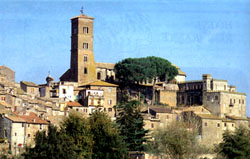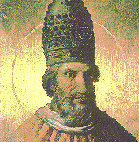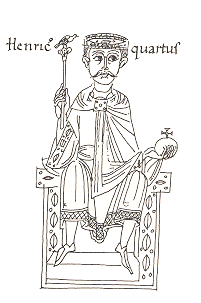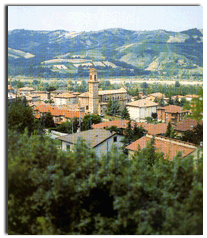WYH2010HF Christianity 843–1648
The Gregorian reforms
Links and resources
Gregorian reform from a University of North Florida class
Two anti-Gregorian texts from the University of Leeds etexts
The empire and the papacy, from a 1921 textbook
D.J. Medley, The Church and the Empire, 1003-1034, published 1910, from Project Gutenberg
Philip Schaff on Gregory VII, Schaff-Herzog Encyclopedia, 1914.
A short history of Sutri, the oldest of the papal states.
John Henry Newman's classical account of the 11th-century Reformation, in his Essays Critical and Historical.
A large bibliography on Gregory VII.
An annotated bibliography on Gregory VII from Spring Hill College.
A short biography of Gregory VII from North Park University, Chicago.
Documents on Canossa: sixteen documents from the Avalon Project, Yale Law School.
Several texts from the period, from the University of Leeds.
Some aphorisms on papal authority, from Gregory VII's register.
A paragraph from the austere Hildebrandine reformer Peter Damian's Liber Gomorrhianus, "the only complete discussion of homosexual activity in the middle ages."
In 1046 the papacy had been a weak institution for centuries, and critically
so since the late 800s. Popes had typically been members of  important
Roman families, or else friends of German emperors with armies in Rome.
In order to survive they needed to maintain the favour of their sponsors,
which meant annoying the enemies of their sponsors, at the risk that these
might at any time gain the upper hand. At the synod of Sutri (the town
is shown here) in 1046, the king of Germany arranged to have three claimaints
to the papal throne deposed, and had his own candidate, the bishop of
Bamberg in Germany, installed as Pope Clement II. Clement's first act
was to crown Henry emperor. Moreover, the emperor had himself named "patrician"
of Rome, which gave him the right to appoint future popes. So far, all
this once again reflected lay control over the papacy. But now, ironically,
the emperor's creatures in the papacy proved very independent minded.
After the short reign of Clement, the brief return of one of the deposed
popes, and the even shorter reign of Damasus II, Leo IX became pope, another
of the emperor's appointees. He had been the bishop of the little German
border town of Toul (which became part of France in 1648). He brought
with him to Rome his chaplain Hildebrand (himself later
the pope, with the name Gregory VII). Leo began the century of reform.
important
Roman families, or else friends of German emperors with armies in Rome.
In order to survive they needed to maintain the favour of their sponsors,
which meant annoying the enemies of their sponsors, at the risk that these
might at any time gain the upper hand. At the synod of Sutri (the town
is shown here) in 1046, the king of Germany arranged to have three claimaints
to the papal throne deposed, and had his own candidate, the bishop of
Bamberg in Germany, installed as Pope Clement II. Clement's first act
was to crown Henry emperor. Moreover, the emperor had himself named "patrician"
of Rome, which gave him the right to appoint future popes. So far, all
this once again reflected lay control over the papacy. But now, ironically,
the emperor's creatures in the papacy proved very independent minded.
After the short reign of Clement, the brief return of one of the deposed
popes, and the even shorter reign of Damasus II, Leo IX became pope, another
of the emperor's appointees. He had been the bishop of the little German
border town of Toul (which became part of France in 1648). He brought
with him to Rome his chaplain Hildebrand (himself later
the pope, with the name Gregory VII). Leo began the century of reform.
Interpretations
The Hildebrandine reforms have classically been interpreted by Roman Catholic writers as necessary, cleansing, and helpful, and by Protestant writers as usurping and tyrannical. Because they pitted leaders in Italy (even if at first they were German!) against German emperors, they have also been interpreted nationalistically. German historians following this line typically regarded the Empire as the First Reich, and saw its humiliation by the papacy as a wrong which history would avenge.
Early reforming popes
- Leo IX (1049–1054). Held synods at Rome, Pavia, Mainz, Reims. Condemned simony, clerical marriage, and the eucharistic heresy of Berengarius. Traveled considerably. Appointed first bishop of Iceland. Tensions with Constantinople on the eve of the schism. War with Normans. Made Hildebrand cardinal-subdeacon and administrator of the papal patrimony.
- Victor II (1054–1057). A kinsman of the emperor; bishop of Eichstatt. A synod at Florence reconfirmed condemnations of simony and clerical marriage; several bishops in violation were deposed. Present at emperor's death; protected the succession of the latter's son (Henry IV).
- Stephen X (1057–1058). Made cardinals of the zealous reformers Peter Damian and Humbert. Tensions with Normans and Constantinople.
- Nicholas II (1058–1061). Was elected through Hildebrand's efforts. Bested an antipope. Received Norman assistance. Supported the reforming Pataria party of Milan. A synod at the Lateran in 1059 decreed that cardinal bishops would nominate, and all cardinals would elect, the pope; the pope granted the emperor the privilege of confirming. This legitimated his own election as pope, which had followed this procedure. A German synod condemned this decree. Berengarius abjured. Lay investiture was condemned. An alliance with the Normans was reached; they would defend the Holy See. Hildebrand was made archdeacon.
- Alexander II (1061–1073). Contested an antipope supported by the imperial regent and Roman aristocratic families. Made Hildebrand chancellor. Supported William of Normandy's conquest of England; appointed Lanfranc primate of England. Punished simoniacal and married clergy.
 Gregory
VII (1073–1085). Was acclaimed by the Roman people. Was
the last pope to be approved by the emperor. Sought alliances to protect
his position. Excommunicated the Norman leader, but later formed an
alliance with him against the emperor. Considered a crusade to defend
Eastern Orthodoxy. Escalated attacks on simony and clerical marriage
and concubinage, against considerable outrage. Condemned
lay investiture; excommunicated those who practiced it.
Gregory
VII (1073–1085). Was acclaimed by the Roman people. Was
the last pope to be approved by the emperor. Sought alliances to protect
his position. Excommunicated the Norman leader, but later formed an
alliance with him against the emperor. Considered a crusade to defend
Eastern Orthodoxy. Escalated attacks on simony and clerical marriage
and concubinage, against considerable outrage. Condemned
lay investiture; excommunicated those who practiced it.
Canossa
 Among the
many who resented Gregory's measures, and his personality, the foremost
was the Emperor Henry IV (pictured here). When the latter deposed
some Saxon bishops perceived as disloyal, and appointed bishops of his
own to take their place, Gregory refused to recognize the new bishops,
and cited the emperor to appear at Rome. The 26-year-old Henry convened
a diet at Worms, 1076, which declared the pope deposed, and the emperor
wrote the pope an unpleasant
letter. Gregory excommunicated the emperor, and freed
his subjects from his rule. The German lords, who didn't support the
emperor anyway, gave him a year to reconcile with the pope, and invited
Gregory to a council at Augsburg. In January 1077, on his way north to
Augsburg, Gregory stayed at a castle at Canossa, Italy, pictured here.
The emperor, meanwhile, came south from Germany to Italy, through a severe
Alpine winter, and learning where Gregory was, came to him as a penitent,
without royal robes, barefoot in the snow, fasting at the door of the
castle.
Among the
many who resented Gregory's measures, and his personality, the foremost
was the Emperor Henry IV (pictured here). When the latter deposed
some Saxon bishops perceived as disloyal, and appointed bishops of his
own to take their place, Gregory refused to recognize the new bishops,
and cited the emperor to appear at Rome. The 26-year-old Henry convened
a diet at Worms, 1076, which declared the pope deposed, and the emperor
wrote the pope an unpleasant
letter. Gregory excommunicated the emperor, and freed
his subjects from his rule. The German lords, who didn't support the
emperor anyway, gave him a year to reconcile with the pope, and invited
Gregory to a council at Augsburg. In January 1077, on his way north to
Augsburg, Gregory stayed at a castle at Canossa, Italy, pictured here.
The emperor, meanwhile, came south from Germany to Italy, through a severe
Alpine winter, and learning where Gregory was, came to him as a penitent,
without royal robes, barefoot in the snow, fasting at the door of the
castle.  After
three days, Gregory finally absolved him, but required him to accept the
decision on the matter of the German lords. Whether the emperor had humiliated
himself in front of the pope, or whether he had cleverly forced the pope
to lift the excommunication, has long been debated.
After
three days, Gregory finally absolved him, but required him to accept the
decision on the matter of the German lords. Whether the emperor had humiliated
himself in front of the pope, or whether he had cleverly forced the pope
to lift the excommunication, has long been debated.
In 1080 the emperor threatened to set up his own pope, and Gregory excommunicated him again. The emperor's armies surrounded Rome in 1081, trapping Gregory, and entered the city in 1084. Norman armies rescued the pope, but their depredations in Rome turned the people against Gregory, who fled Rome and died in exile the following year.
Later reforming popes
- Victor III (1086–1087). Formerly abbot of Monte Cassino. Enjoyed good relations with the Normans. Supported the Hildebrandine reforms but didn't support Gregory VII's intransigence. Was eElected pope against his will; refused to serve and retreated to Monte Cassino; finally allowed himself to be enthroned at Rome, but returned to Monte Cassino; held a council at Benevento, took sick, and died.
- Urban II (1088–1099 ). Former prior of Cluny; became Pope Gregory VII's chief adviser, and a cardinal bishop. For most of his first six years, Rome was held by an antipope. Excommunicated the French king for adultery. Declared the first crusade at a council in Clermont, 1095. Crusading princes helped him regain Rome. Called a council at Bari, 1098, to deal with the filioque clause.
- Paschal II (1099–1118). Formerly a Cluniac monk; a cardinal priest under Gregory VII. Continued opposition to lay investiture; continued to support the crusading spirit; absolved the king of France after penance. Papal schism was practically ended. Settled the investiture controversy with Henry I of England, 1106 (the model for the Concordat of Worms, 1122). Kidnapped and harshly imprisoned by the emperor for two months in 1111; enacted the "Privilegium," renouncing Gregory VII's claims; the Privilegium was quickly repudiated by a Hildebrandine council. Sanctioned the excommunication of the emperor, 1112; forced from Rome by emperor, 1115–1118.
- Gelasius II (1118–1119). Formerly a monk; then adviser to Paschal II. The emperor Henry V, with his military allies in Rome, supported an antipope; Gelasius sought refuge first among the Normans and then among the French at Cluny.
- Callistus II (1119–1124). Son of the count of Burgundy, he was connected with several royal houses in Europe, which helped him as pope. Was bishop of Vienne before being elected to Rome. Established his power in Italy with Norman help; imprisoned the antipope. Negotiated with the emperor; the Concordat of Worms (1122) acknowledged the church's possessions and settled the investiture controversy (the emperor grants free episcopal elections, but in the presence of his delegates; the pope will invest bishops with their spiritual authority, by giving them ring and crozier, while the emperor will invest them with their temporal authority, by giving them their sceptre). Convened the First Lateran Council, 1123, to confirm the Concordat of Worms, and to enact reforming decrees. Sought to restore order to Rome.